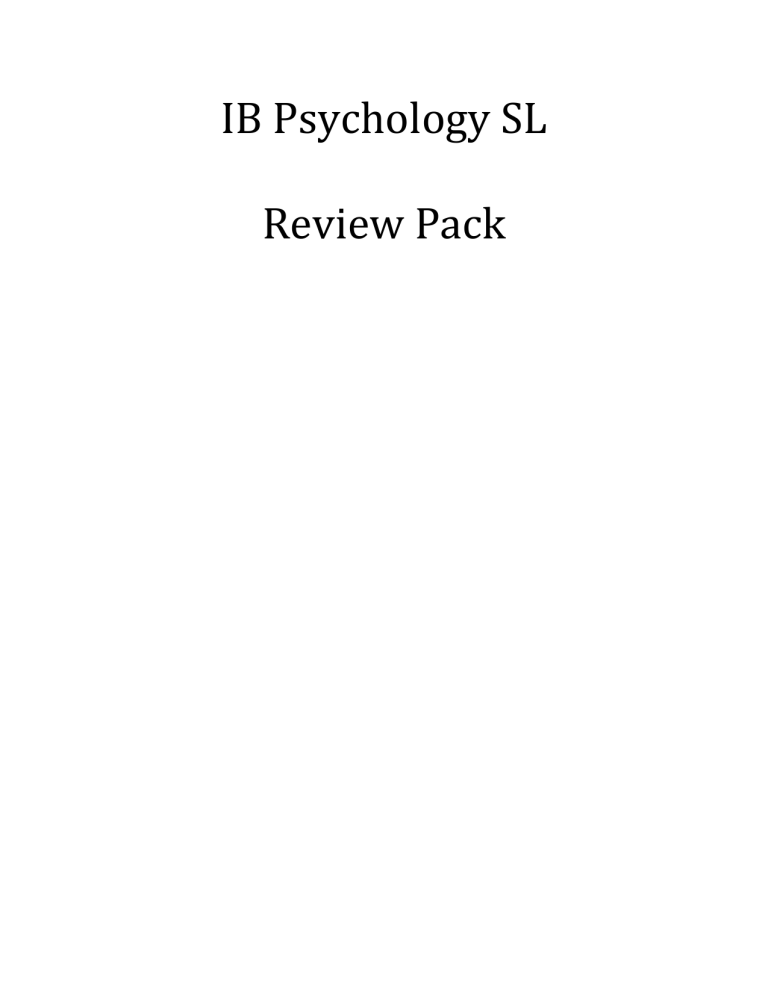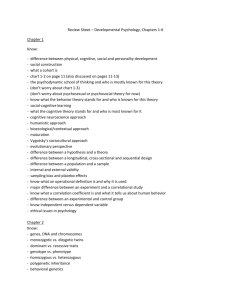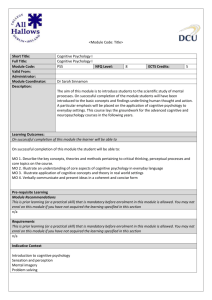IB Psychology Review SL

IB Psychology SL
Review Pack
2012-04-04
This review guide will take you through sections of the course companion guide and will provide you with the basics that you need to pass the IB exam. Additional information covered in class and in your independent readings will not be included in this packet and you are responsible for reviewing that information prior to the exam.
Below is the exam schedule for IB Psychology Exams 2012. Note the session time slots .
Wednesday 2 May Afternoon Exam Psychology SL paper 1 2h
Thursday 3 May Morning Exam Psychology SL paper 2 1h
Command terms with definitions
Students should be familiar with the following key terms and phrases used in examination questions, which are to be understood as defined below. Although these terms will be used frequently in examination questions, other terms may be used to direct students to present an argument in a specific way.
These command terms are grouped under associated assessment objectives in the section
“Assessment objectives in practice”.
Analyze - Break down in order to bring out the essential elements or structure.
Apply - Use an idea, equation, principle, theory or law in relation to a given problem or issue.
Compare - Give an account of the similarities between two (or more) items or situations, referring to both (all) of them throughout.
Compare and contrast - Give an account of similarities and differences between two (or more) items or situations, referring to both (all) of them throughout.
Contrast - Give an account of the differences between two (or more) items or situations, referring to both (all) of them throughout.
Define - Give the precise meaning of a word, phrase, concept or physical quantity.
Describe - Give a detailed account.
Discuss - Offer a considered and balanced review that includes a range of arguments, factors or hypotheses. Opinions or conclusions should be presented clearly and supported
2
2012-04-04 by appropriate evidence.
Distinguish - Make clear the differences between two or more concepts or items.
Evaluate - Make an appraisal by weighing up the strengths and limitations.
Examine - Consider an argument or concept in a way that uncovers the assumptions and interrelationships of the issue.
Explain - Give a detailed account including reasons or causes.
Outline - Give a brief account or summary.
State - Give a specific name, value or other brief answer without explanation or calculation.
To what extent - Consider the merits or otherwise of an argument or concept. Opinions and conclusions should be presented clearly and supported with appropriate evidence and sound argument.
3
2012-04-04
What is Psychology?
We humans share the belief that if we can discover the causes of behavior, we will be able to explain them, and maybe also control them. This is a typical reductionist view that may not be supported by current research and the study of the various levels of analysis.
Definition of Psychology
A common definition of psychology is:
The difficulty with this definition as it is now is that it fails to provide a clear description of what psychology is.
The important parts of the definition are:
1.
Scientific, meaning it is
2.
Mental processes and behavior
3.
Two processes that effect behavior
R.D. Rosen (1977) coined the term “psychobabble” referring to He further stated that the difference between the two psychologies is .
Geoffrey Dean (1987) conducted research on to determine the difference between a standardized inventory such as and birth charts, as it related to the personality characteristics of introversion vs. extroversion. The results were .
Nanninga (1996/97) studied the value of astrology.
What are some of the root sciences that provide knowledge to Psychology?
1.
2.
3.
4.
They study a wide variety of topics such as: (not limited too)
1.
2.
3.
4.
5.
6.
7.
8.
9.
4
2012-04-04
10.
The exposure to other sciences is a distinct advantage to psychology because
One example of this cross discipline combination is bringing together cognitive neuroscience with the unlikely partner of .
Levels of Analysis:
1.
Biological Level of Analysis
2.
Cognitive Level of Analysis
3.
Sociocultural Level of Analysis
How would each of these levels explain learning behaviors?
1.
2.
3.
A very brief history of psychology: from philosophy to scientific psychology.
Origin of the word psychology is: and which leads to the philosophy of the mind.
Define: Epistemology
With human beings, in what ways to we know the world? , , , ,
&
In what ways have psychologists pursued their study over time:
America
Europe
Modern Scientific Psychology:
Terms associated with modern scientific psychology:
Theories
5
2012-04-04
Empirical studies
Concepts
Self – efficacy
Mindset
Fixed mindset
Growth mindset
Dweck & Blackwell (2007) conducted experiments with low achieving students. They found what?
Questions:
1. a) What ways of knowing is scientific psychology based on? b) How do you know this? a) b)
2 . a) What ways of knowing is common sense psychology based on? b) How do you know this? a) b)
6
2012-04-04
Understanding the research process:
Define and understand the following terms:
Aim
Target population
Procedure
Findings
Participants
Sample
Representative sample
Opportunity sampling (convenience sampling)
Sampling bias
Sears (1986) looked at sampling bias in what area? And his findings were?
Which means what?
Other sampling methods:
Self-selected sample
Snowball sampling
Random sampling
Stratified sample
Considerations in sampling:
Ethics in research :
What steps should be taken prior to any psychological study to ensure, as much a possible, the ethical treatment of participants?
What are the elements of current ethical guidelines:
1.
2.
3.
4.
5.
6.
7
2012-04-04
Go back to the beginning of the chapter and reread the study by Rosenthal and Jacobson.
(p. 18) Was the study ethical? State your reasons
Evaluating Findings:
Interpreting and presenting findings is essential to the scientific method and to psychology.
What are some applications of empirical study and the theory that underlies it?
Define and understand the following:
Validity
Ecological validity
Cross-cultural validity
Ethnocentric
Reliable
What are some of the things to look for when you are evaluating a study?
Research in psychology: Experimental Methods.
The Aim of the study can and often is similar to any other methodology with the exception that experiments, because of the nature of the controls involved, can lead to establishment of & . This is something that no other methodology can accomplish.
Define and Understand:
Independent variable (IV)
Dependent variable (DV)
Operationalized
8
2012-04-04
Experimental hypothesis
Control condition
Laboratory experiments
Field experiments
Natural experiment Give a current example of a possible natural experiment
.
Tiffany Field conducted experiments relating to
Points to consider with experiments:
Confounding variables
Demand characteristics Also know as How to control An example of
Researcher bias How to control
Participant variability How to control
Artificiality
Correlational Studies:
Positive correlation Example:
Negative correlation Example:
Bidirectional ambiguity
A 1999 Hong Kong study quoted by Zimbardo (1999) found a positive correlation between appliance ownership and the practice of safe sex. Sometimes a strong correlation does not actually exist.
Non-Experimental Methods: qualitative research
Experimental methods emphasizes reliability, validity, replicability and generalizability.
In non experimental methods sometimes reliability etc. is made richer by triangulation .
How would triangulation be beneficial? What types of triangulation can be used?
Experimental methods utilize a approach stating the hypothesis or claim that is tested against empirical evidence.
9
2012-04-04
Qualitative research uses the approach, looking at the evidence derived from the study letting that define the variables.
Some Qualitative Methods:
Interview:
Types of Interviews
Structured interview -
Unstructured interview -
Semi-Structured interview -
Be aware of:
Interviewer effects, which are
Social desirability bias, which is
Participant bias, which is
Ethical Considerations -
Observation:
Naturalistic Observation -
Considerations;
Researcher bias -
Inter-observer reliability -
Participant observation -
Reactivity -
Covert observation -
Overt observation -
Ethics in observational research -
Rosenhan (1973) Covert participant observation -
Case Studies: Strengths - Limitations - Ethics -
Money (1974)
Outline two ethical problems in this case study.
What could be the reason that Money continued to use this case as evidence of his theory of gender neutrality?
10
2012-04-04
Biological Level of Analysis: Physiology and Behavior
Principles of Biological Level of Analysis (2.1)
Principles of Biological Level of Analysis:
1.
2.
3.
The relationship between the biological systems and the environment is a relationship or symbiotic in nature.
One of the great debates in the biological level is that of vs. as a way of viewing contributing factors in behavior and cognitive processes.
Currently most psychologists take an approach adopting a more holistic view of behavior and its antecedents.
The approach is often in nature trying to break down behavior to its smallest antecedent such as neurotransmitters, genetic code or a particular protein.
Weakness Research Methods: Strengths
Researchers
Kasamatsu & Hirai
(1999)
Martinez & Kesner
Theory/Investigation Methods
(1991)
Otto Loewi (1921)
Findings
John Harlow
Paul Broca (1861)
Carl Wernicke
(1874)
Kim & Hirsch
(1997)
Robert Heath
(1950’s & 1972)
James Olds
Hetherington &
Ranson (1942)
Gur et al. (1995)
Hubel & Weisel
11
2012-04-04
(1965)
Rosenzweig &
Bennett (1972)
Richard Davidson
(2004)
Rauscher et al.
(1993)
Gallese et al.
(1996)
Marco Iacoboni
(2004)
V.S.
Ramachandran
Mechanisms of neurotransmission define and understand
Neurons -
Neurotransmission -
Neurotransmitters -
Synapse -
Terminal buttons -
Reuptake -
Acetylcholine -
Dopamine -
Norepinephrine – aka -
Serotonin -
Endorphin -
Oxytocin -
Use of technology to study the brain:
Invasive techniques -
EEG -
12
2012-04-04
PET -
MRI - fMRI -
Evaluating Brain Scanning Techniques:
With reference to one empirical study explain how environmental factors can affect one physiological process.
Biological Level of Analysis: genetics and behavior (2.2)
The idea of understanding how genetics and environment combine to explain behavior is know as . Although a person may have a genetic predisposition to exhibit certain behaviors or present a particular disorder psychologists know that it cannot all be explained through genetics. The environment plays a significant role in how genes present themselves which is explained utilizing the - , arguing that the interaction with the environment triggers the genetic vulnerability.
Genetic Research:
Much of the research in genetics is based on studies where researchers look at how different variables may co-vary. This simply means that variables studied relate to each other to a greater or lesser degree. It does not establish cause and effect.
Twin studies, family studies and adoption studies are ways of sequestering variables to allow for estimates of genetic or environmental dominance.
Genetically identical twins are known as .
Twins from two eggs are known as .
Any correlations determined in twin studies are known as .
Family studies are another mechanism for studying the effects of inheritance in the general population. It provides a more representative sample of the general population.
Adoption studies provide a final method used for genetic research. This provides a more general comparison of genetic and environmental influence on behavior. A criticism of adoption studies is the practice of selective placement by adoption agency’s.
Richard J. Herrnstein (1994) wrote .
13
2012-04-04
“Give e a dozen healthy infants and my own specific world to bring them up in, and I’ll guarantee to take any one at random and train him to become any type of specialist I might select – doctor, lawyer, artist, merchant, chef and yes, even beggar and thief, regardless of his talents, penchants, tendencies, abilities, vocations and race of his ancestors” . This statement was made by the father of American .
Bouchard & McGue (1981) completed a - through the review of 111 studies of IQ correlations.
The Minnesota Twin Study (Bouchard et al. (1990) is a longitudinal study of .
Some criticisms of the Minnesota Twin Study are:
1.
2.
3.
4.
Scarr & Weinberg (1977) and Horn et al. (1979) focused on .
Wahlstein (1977) looked at adoption studies in France which found .
Plomin & Petrill (1997) .
Evolution and Evolutionary Psychology (pp. 57-60)
Discuss the extent to which genetic inheritance influences behavior with reference to relevant research studies. .
14
2012-04-04
Cognitive Level of Analysis: Cognitive Process (p. 67)
Principles of cognitive level of analysis:
1.
2.
3.
Research Methods:
Researchers
Dweck
Neisser (1960)
Bartlett (1932)
Anderson &
Prichert (1078)
Cohen (1993)
Atkinson &
Shiffrin (1968)
Baddeley & Hitch
(1974)
Pickering &
Gathercole (2001)
Holmes et al.
(2008)
Kandel (2000)
Cole & Scribner
(1974)
Rogoff & Wadell
(1982)
Loftus (2000)
Loftus & Palmer
(1974)
Yuille & Cutshall
(9186)
Mosconi (2005)
Define and Understand:
Strengths
Theory/Investigation Methods
Cognitive Psychology -
Cognitive Neuroscience -
Weakness
Findings
15
2012-04-04
Cognitive processes include
Cognition refers to
Bottom-up processing
Top-down processing
Stereotyping
Memory is in nature and may produce because the mind cannot distinguish between what was experienced and what was heard about the experience.
A mental representation of knowledge is called a .
Pre-stored mental representations of images or ideas are referred to as .
Schema theory and memory processes:
Transforming sensory information into meaningful memory is know as
Creating a biological trace of the encoded information in memory, which is either consolidated or lost is .
Using this stored information is called .
Explain the Atkinson & Shiffrin model of working memory:
Explain the difference between this model and that of Baddeley & Hitch with regarding to working memory. .
Ethics in Research:
HM & Clive Wearing are famous case studies in cognitive psychology. HM has been studied extensively, with all kinds of tests, ever since his operation in 1953. He has even donated his brain to science when he dies. We do not know his identity. Clive Wearing’s identity is known to us due to his wife’s book
.
1.
Discuss why participants in case studies are normally anonymous.
2.
Discuss the ethical considerations in studying an individual with an interesting disorder or brain damage, such as HM and Clive Wearing.
Discuss how social or cultural factors affect ones cognitive process. (the word “or” in the question means to discuss one factor, social or cultural, in your answer) .
16
2012-04-04
Explain the use of technology in investigating the relationship between cognitive factors and behavior (e.g. EEG, fMRI, computer simulation) .
Cognitive Level of Analysis: cognition and emotion (p. 88)
There are three components of emotion:
1. , such as arousal of the autonomic nervous system and the endocrine system that are not conscious
2. the person’s own of an emotion (e.g. happiness)
3. , such as smiling or running away.
Biological factors in emotion:
According to brain researchers emotions serve a particular purpose: . Lazarus and Folkman suggest that it is not the emotion that is important but the or interpretation of the situation that is important.
In The Emotional Brain (1999) LeDoux describes two biological pathways of emotions in the brain. The first is . The second is the . It is believed this serves a particular purpose which is .
Cognitive aspects of emotion:
According to Lazarus, appraisals are evaluations related to how the situation will impact on one’s personal well-being.
Lazarus (1975) -
Lazarus & Folkman (1984) -
Folkman & Lazarus (1988) -
Speisman et al. (1964) -
Emotion and cognitive process: the flashbulb theory.
Brown and Kulik (1977) -
Neisser (1982) -
Neisser & Harsch (1992) -
Telarico & Rubin (2003) -
17
2012-04-04
Breckler (1994) -
Holmberg & Holmes (1994) -
Explain the interaction between cognitive and biological factors in emotion. .
An integrative look at Happiness: (p. 93)
Lyubomirsky (2001) – speaks about a genetic set point for happiness
Jeremy Bentham (1780) defined happiness as and wrote about it in his book
. One could day he was the first Behavioral Economist.
Cognitive factors in happiness: beliefs about happiness
Psychologist explain the lack of happiness in the western world, despite increase wealth because of a variety of factors: 1. based on Leon Festinger’s work. 2.
Julian Rotter proposed the which is .
Myers & Dieners (1995) have shown
Hagerty (2003) completed a cross cultural study involving countries that showed there is a relationship between happiness and where the concept of
, or leads to dissatisfaction.
Johnson & Kruger (2006) -
Conway, di Fazio, & Mayman (1999) -
18
2012-04-04
Sociocultural level of analysis: sociocultural cognition (p. 101)
Principles of sociocultural level of analysis:
1.
2.
3.
4.
Research Methods:
Kashima &
Triandis (1986)
Leung & Wan
(1982)
Henri Tajfel
Moscovici (1973)
Adler (1990)
Caroline Howarth
(2002)
Aronson (1995)
Steele (1997)
Spencer et al.
(1977)
Hamilton &
Gifford (1976)
Rogers & Franz
(1962)
Strengths
Researchers
O’Reilly (2000)
Festinger et al.
(1956)
E.E, Evans-
Pritchard
Fritz Heider
Theory/Investigation Strengths
Lee et al. (1977)
Lau & Russel
(1980)
Miller & Ross
(1975)
Greenberg et al.
(1982)
Weakness
Weaknesses
19
2012-04-04
Explain the use of one research method at the sociocultural level of analysis.
Attribution Theory
Define and understand:
Attribution -
Actor – Observer Effect -
Situational factors -
Dispositional factors -
Errors in Attribution:
Fundamental Attribution Error -
Self-serving Bias -
Modesty Bias -
Social Identity Theory:
Social Identity Theory -
Social Categorization -
In-group -
Out-group -
Social comparison -
Social Representations:
Social representations -
Social cognition -
Stereotyping -
Stereotype Threat -
Spotlight Anxiety -
20
2012-04-04
The formation of stereotypes:
Social categorization -
Gatekeepers -
Grain of truth hypothesis -
Illusory correlation -
Confirmation bias -
Social desirability effect -
Find two examples of stereotypes in the media – newspapers, magazines, books, packaging, products, posters, or films. For class bring in the images and be able to explain why the image represents a stereotype and why you think this image persists.
Sociocultural level of analysis: social and cultural norms: (p. 111)
Norm -
Social Learning Theory:
Social learning theory -
Observational learning -
Albert Bandura -
According to Bandura, social learning involves the following factors.
1. - the person must first pay attention to the model.
2. - the observer must be able to remember the behavior that has been observed.
3. - the observer has to be able to replicate the action.
4. - learners must want to demonstrate what they have learned.
5. - If the model behaves in a way that is consistent across situations.
6. - There is a tendency to imitate models who are like ourselves.
21
2012-04-04
7. - Bandura argues that people can lean from observing what happens to others; they don’t have to experience the consequences themselves. This is called
in Bandura’s theory.
8. Warm and friendly models are more likely to be imitated than cold, uncaring models.
Application of social learning theory in real life: ecological validity
Is the observation of violence in media likely to lead to violence in life?
Huesmann & Eron (1986) -
Kimball & Zabrack (1986) -
Carlton et al. (2002) -
Sabido Method -
With reference to one research study explain social learning theory.
Social Influence: compliance:
Robert Cialdini -
Compliance techniques -
Cialdini’s Six factors of influence:
1.
Authority
2.
Commitment
3.
Liking
4.
Reciprocity
5.
Scarcity
6.
Social proof
Kurt Lewin (1951) goal gradients and commitment -
Foot-in-the-door-technique -
Cialdini et al. (1974)
Low balling -
Hazing -
22
2012-04-04
Asch (1955) – Asch’s paradigm
Group size -
Unanimity -
Confidence -
Self-esteem -
Moscovici & Lage (1976) – a different view of Asch’s paradigm.
Group think -
Why do people conform?
What is the role of culture in conformity?
Etic approach -
Emic approach -
Cultural dimensions of behavior:
Hoefstede (1973) -
Dimension 1 – individualism / collectivism .
Dimension 2 – uncertainty / avoidance
Bond (1988)
Hall’s proxemics theory (1996)
23
2012-04-04
Health Psychology: Stress (p. 220)
This area of study will bring together your understanding of the biological, cognitive and sociocultural levels of analysis.
Today most of our health problems are not related to specific pathogens causing infections but rather are related to lifestyle.
Aaron Antonovsky -
Health is a state of complete physical, mental and social well-being, and not merely the
absence of disease and infirmity. (World Health Organization)
Health psychologists are concerned with understanding how different factors, such as , , and influence health behavior.
The model followed by health psychologists is know as the model of health and illness.
Behaviors such as .
Biological factors such as
Sociocultural factors including
Psychological factors including
Stress and stressors:
Stress is describes as
Acute stressors -
Chronic stressors -
Work and Student stressors
Holmes-Rahe Scale (1967)
List 5 stressors that you have encountered in the past year. , , ,
,
How did you react to each of these events, physiologically and psychologically?
Physiologically:
Psychologically:
24
2012-04-04
Sarafino (1994) -
Steptoe & Marmot (2003) -
Physiological Aspects of Stress:
Cannon (1914) -
Hans Selye (1956) -
Cortisol in Stress -
Kiecolt-Glasser et al. (1984) -
Cognitive aspects of Stress:
Reed et al. (1999) -
Kemeny et al. (2006) -
Kamen & Seligman (1987) -
Greer et al. (1979) -
Social self-preservation theory (Kemeny et al. (2005) -
Psychoneuroimmunology (PNI) is
Coping and coping strategies:
Lazarus & Folkman (1975) created the transactional model of stress which is based on . Out of this comes the inclusion of the appraisal model with two subcategories known as and .
Lazarus & Folkman (1988) suggested two main coping strategies.
1. - which is
2. - which is
Carver (2007) speaks to the distinction between these two ways of coping by .
Ursin & Reison (2004) found
25
2012-04-04
Social Support as a coping strategy:
Gilles et al. (1992-2005) – discussed social support in this longitudinal study to determine life expectancy.
Social Support -
The social support can come from
And can include , and/or .
Taylor (2002) completed a and discovered a gender difference in relation to social support. Women . Men .
Thoits (1995) -
Belle (1987) -
Whiting & Whiting (1975) - .
Taylor (2008) spoke to the issue of culture in coping with stress by finding .
Evans (1979) found out that approximately 15 million Americans participate in support groups for HIV, cancer, obesity or alcoholism as their primary vehicle for mental health services.
Kessler et al. (1997) at some point in their lives.
Davison et al. (2000)
Internet based support groups:
Klemm et al. (1999) (this is really early in the development of the internet as a resource) The methodology was
Wenzelbert et al. (2003)
Mindfulness stress reduction as a coping strategy:
Core practices of MBSR include:
26





